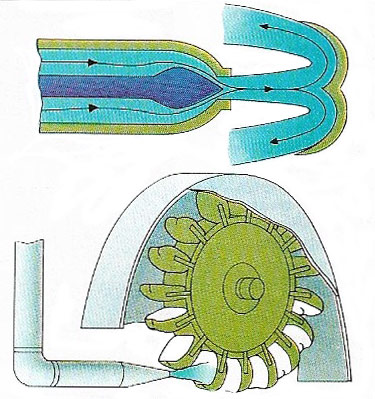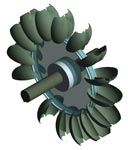Pelton turbine

In the Pelton wheel or impulse turbine the water passes through a jet and strikes bucket-shaped paddles on the wheel. The direction of the water flow is reversed.
A Pelton turbine, also called a free-jet turbine or Pelton wheel, is a type of impulse turbine, named after L. A. Pelton who invented it in 1880. Water passes through nozzles and strikes spoon-shaped buckets or cups arranged on the periphery of a runner, or wheel, which causes the runner to rotate, producing mechanical energy. The runner is fixed on a shaft, and the rotational motion of the turbine is transmitted by the shaft to a generator.
 |
Pelton turbines are suited to high head, low flow applications. Typically, to work this type of turbine, water is piped down a hillside so that at the lower end of the pipe it emerges from a narrow nozzle as a jet with very high velocity. The Pelton turbine can be controlled by adjusting the flow of water to the buckets. In order to stop the wheel a valve is used to shut off the water completely. Small adjustments, necessitated by alterations in the load on the generator, are more safely made by a device which deflects part of the water jet away from the buckets.
Pelton wheels are are used in storage power stations with downward gradients up to 2,000 meters and can contain up to 6 nozzles. Compare with the Francis turbine and the Kaplan turbine.
